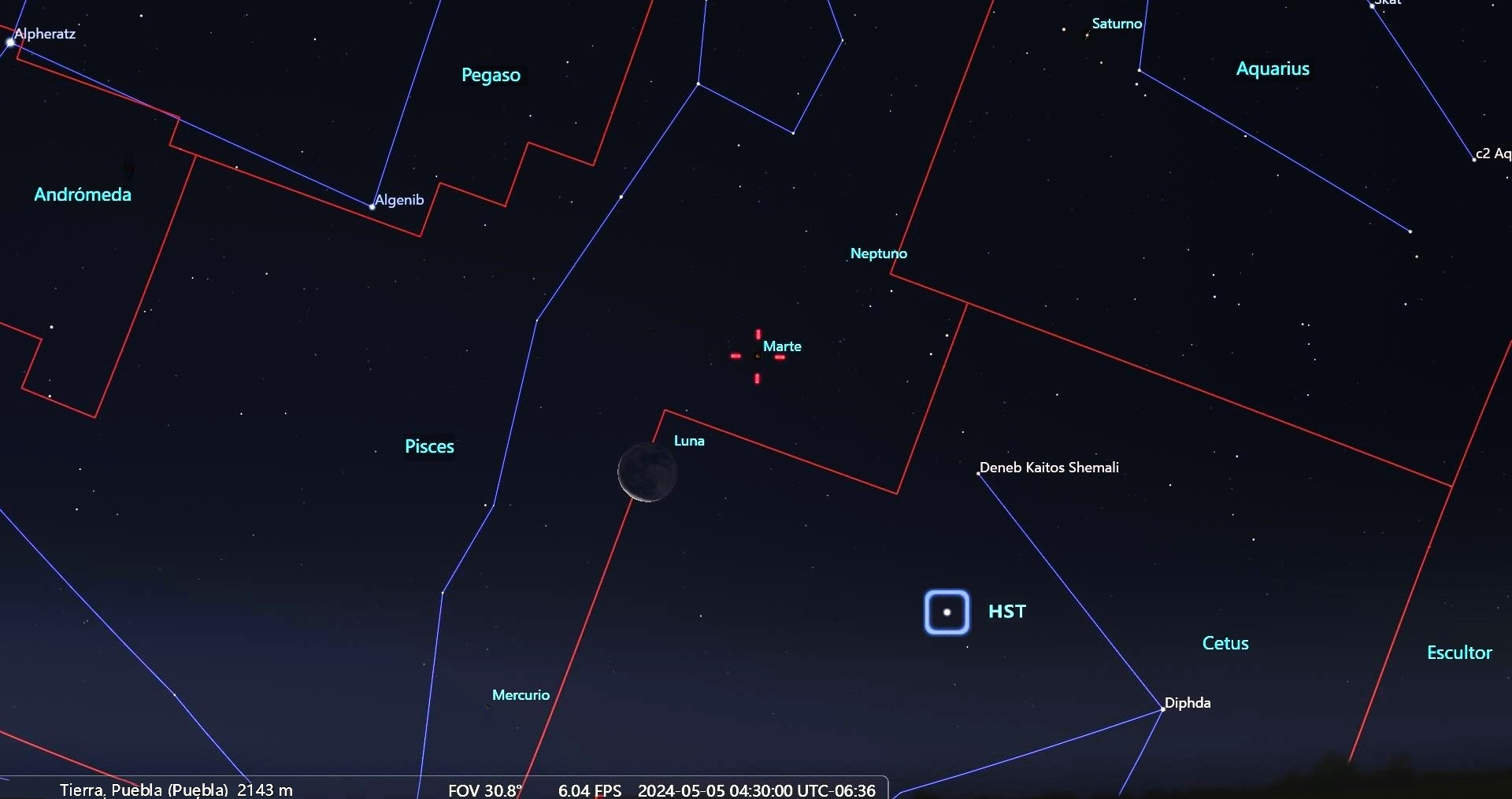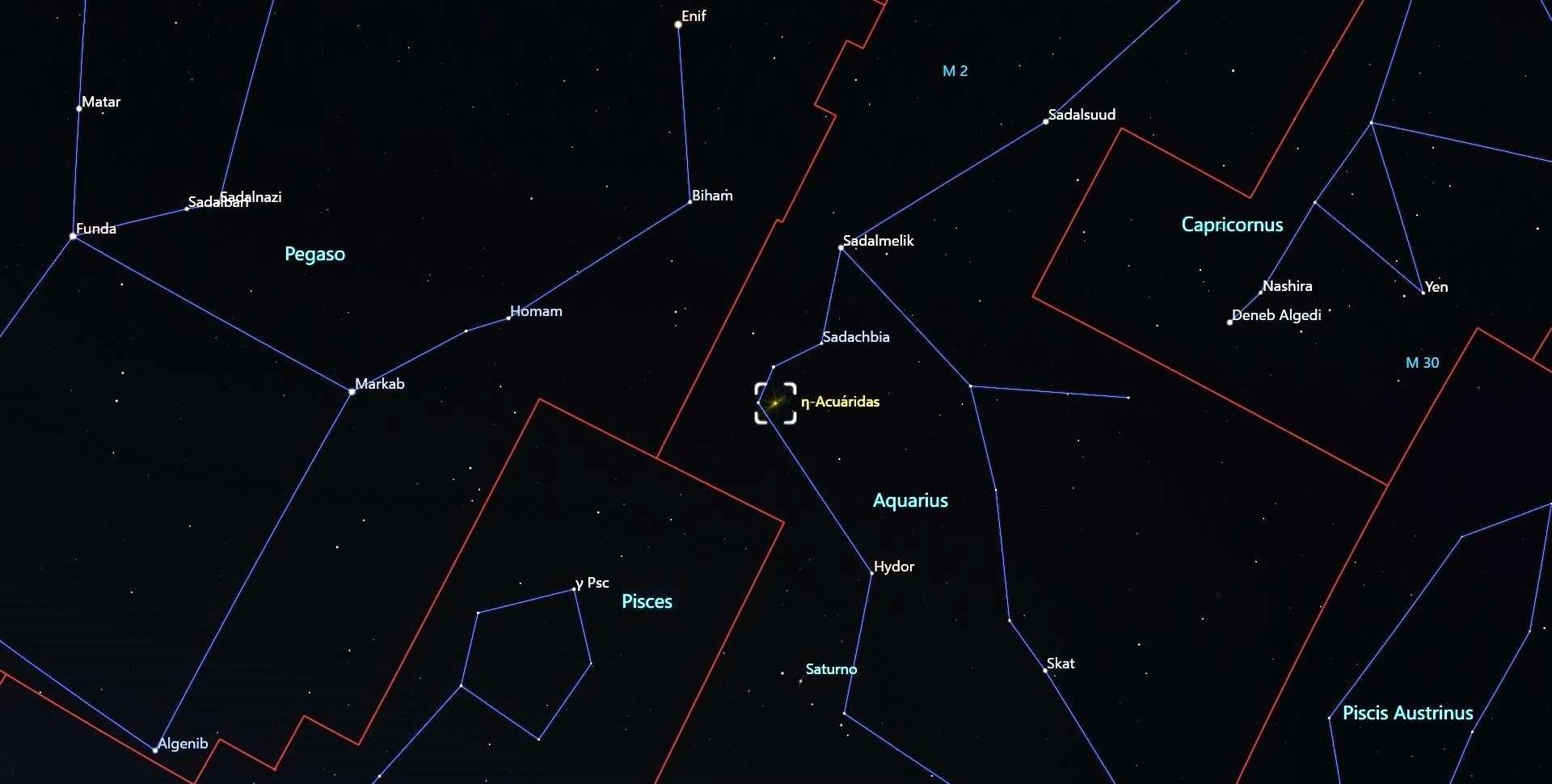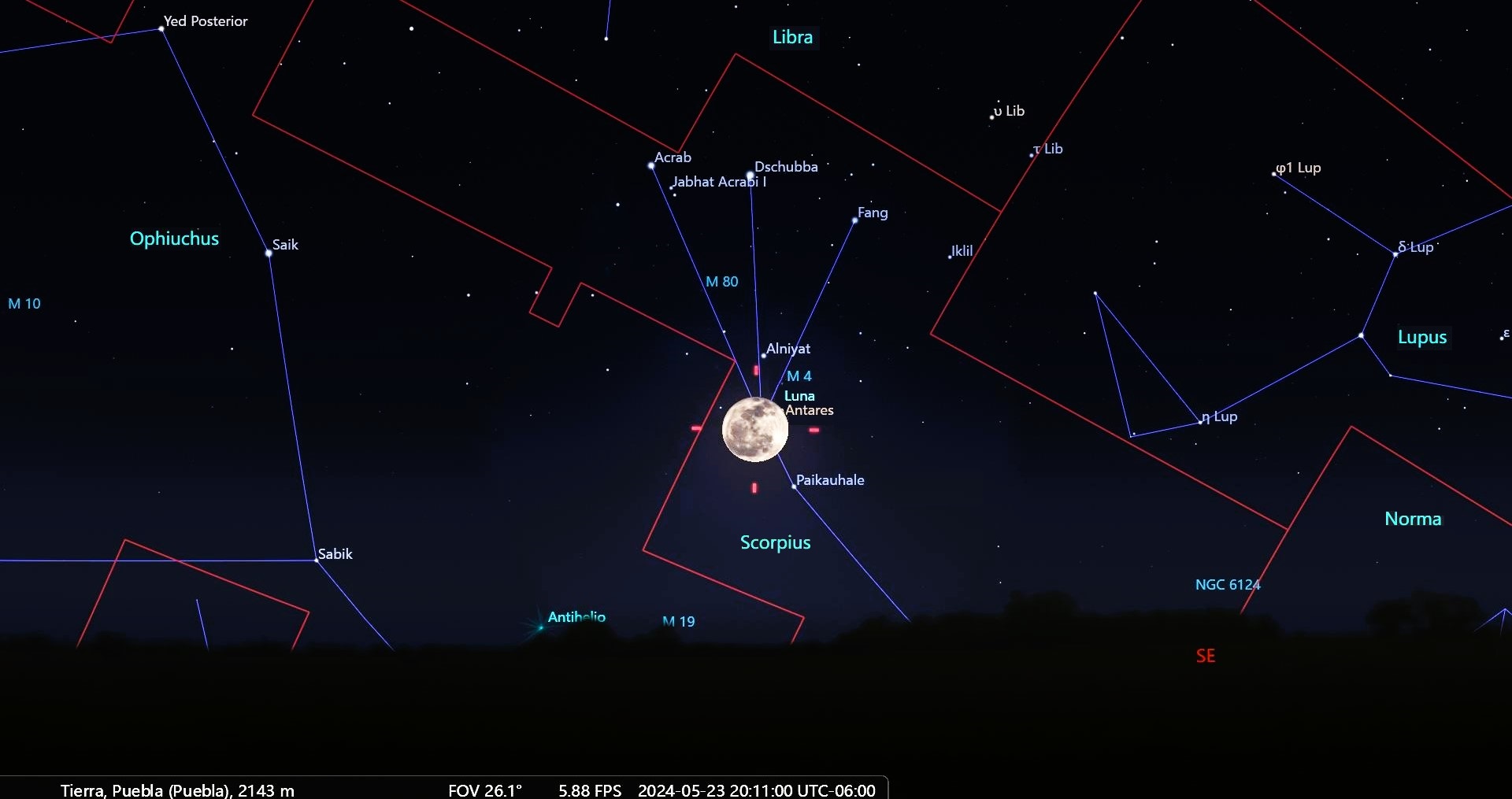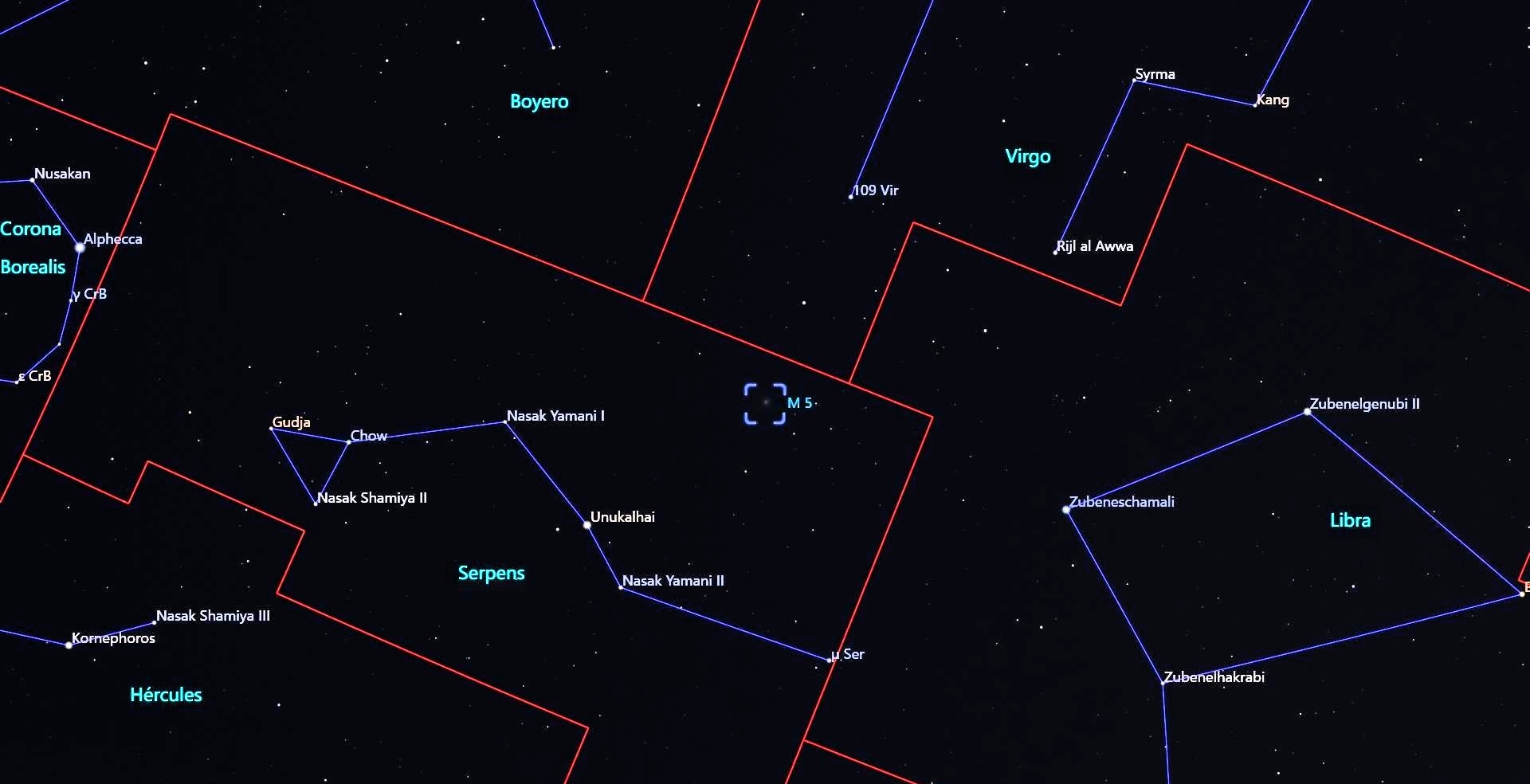Astronomical events for the month of May 2024
This month we will travel back in time to ancient Persia to meet a great astronomer. The Moon will have several approaches and conjunctions with various planets, giving us colorful postcards. There will also be a moderate meteor shower, the η-Aquarids. Although occultations are common, they are rarely observed, here we will tell you why. As a challenge of the month, we propose the old globular cluster M5. At the end, we present the phases of the Moon.
An astronomer of Persian origin
It is sometimes believed that the configuration of the firmament, as we know it today, was established by the Greeks and Romans. However, during the Middle Ages, this part of the world experienced scientific stagnation, while in the East science flourished. Astronomy, in that region, grew with Abd al-Rahman al-Sufi (Azophi), an astronomer who lived in Persia (present-day Iran) in the 10th century AD. He worked on translations and compilations of ancient Greek works, including Ptolemy's Almagest, improving and expanding star maps with information on magnitudes, colors, positions, constellation conformation, and extensive use of the astrolabe. Among his contributions are stellar variability, the Andromeda galaxy as a small cloud, the Magellanic Clouds, among others. His work was documented in the “Book of Fixed Stars”, one of his works published in the year 964, where he captures, with drawings, the stars and constellations. Abd al-Rahman al-Sufi died in May 986, aged 81, but his name was immortalized on the Moon, the Azophi crater.

Planetary approach
For a long time, the objects of our solar system have been observed, it has been concluded that the planets and their moons orbit the Sun at different speeds, moving in the sky at different times, changing position continuously. To locate the positions, the astronomical coordinates of Right Ascension and Declination are generally used. This leads to planetary conjunctions occurring at certain times, that is, two or more objects in the solar system sharing one of their coordinates, Right Ascension.
On the other hand, we have planetary approaches, which are purely visual phenomena, when objects appear to be together in a small portion of space, seen from Earth.
From May 3 to 6, our natural satellite, the Moon, will be making some conjunctions with Saturn, Mars and Mercury and a close approach with Neptune, giving an optical planetary alignment at dawn on May 5. This day, at 4:30 am, with some luck and a clear horizon, we will be able to see the Hubble Space Telescope.
Spring shower
There are luminous phenomena that occur when small particles of dust and rock (meteoroids), which surround the Earth, enter the atmosphere at high speed, burning due to friction with the air as they fall, creating a bright flash (meteor). When an isolated event occurs, it is commonly known as a “shooting star” (meteor) and when there are associated and numerous events, they are known as a “star shower” or “meteor shower.” When the fragments survive disintegration and they fall to the ground they are known as meteorites.
The η-Aquarid meteor shower will be active from April 19 to May 28, with a maximum on May 6. The maximum observable rate will be 40 meteors per hour. The radiant is located in the direction of the constellation of Aquarius, towards the eastern part of the celestial sphere. It has been determined that the object responsible for this shower is Comet 1P/Halley. The rain will be observable, preferably, in the early mornings of May 5 and 6.
Antares disappears momentarily
The Scorpio constellation is a southern, classic summer constellation. It is one of the twelve members of the zodiac, represented as a scorpion and its brightest star is Antares, the α star. The Sun passes over it every year, for a week at the end of November.
On May 23, between 7:11 p.m. and 11:24 p.m., central Mexico time, the Moon, in its orbit around the Sun, will pass in front of the star Antares, causing what, astronomically speaking, is known as a lunar occultation. .
For any observer of the night sky, around this time, the Moon will have a close approach with the star Antares (α Scorpio), but only some will be able to observe this lunar occultation. This is because occultations are very localized events and the angular sizes of the objects are very small compared to the angular size of the Moon, which is precisely what differentiates it from an eclipse, where the angular sizes of the objects are similar.
Due to the very nature of occultations, it is recommended to use stellar applications such as Skymap or Stellarium. The latter is an open source program, for phone or computer that shows the sky in 2D, as seen with the naked eye, with binoculars or a telescope. Stellarium has a free version on the page: https:// stellarium.org/es/
A cluster with a lot of history
The enormous constellation of Serpens (the Serpent) is a summer constellation that covers both the northern and southern hemispheres, it was introduced by Ptolemy in the 2nd century AD.
In the northern part of this vast region we find one of the oldest globular clusters in the galaxy, the globular cluster M5, NGC 5904 or Pink Cluster. It was discovered in 1702 by the spouses Golffried Kirch and Maria Margarethe, Messier rediscovered and cataloged it in 1764, describing it as a nebular object; William Herschel identified stars, in that small cloud, only until 1791. It is estimated that it has 100,000 stars and that it is located 24,500 light years from us, it is also believed that it has an age of 13,000 million years, which makes it one of the oldest objects in our galaxy. It has been estimated that it has a diameter of 130 light years, which makes it truly one of the largest and longest-lived.
With very good visibility conditions, it can be seen with the naked eye. With binoculars you can see a small hazy spot and with a small telescope you will see a bright cloud towards the center, but with moderate aperture telescopes you will see concentric bright rings and some stars.
Phases of the Moon (Central Mexico time).
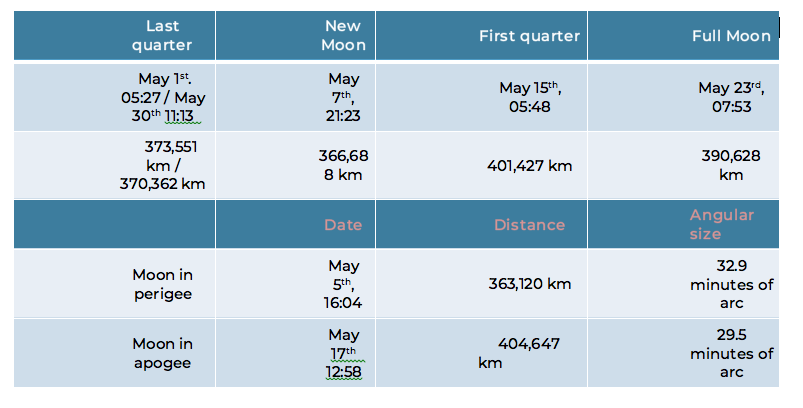
Contacts:
Dr. Agustín Márquez Limón (amarquez@inaoep.mx), Coordinación de Astrofísica-INAOE
M.C. Tania Martínez (astronomaplanetariokayok@gmail.com), Red de Planetarios del Estado de Quintana Roo
Dr. Raúl Mújica García (rmujica@inaoep.mx), Coordinación de Astrofísica-INAOE y Noche de las Estrellas
Luis Enrique Erro # 1, Tonantzintla, Puebla, México, Código Postal 72840, Tel: (222) 266.31.00, difusion@inaoep.mx
This work is licensed under a Creative Commons Attribution-NonCommercial-NoDerivs 2.5 Mexico License.


